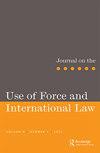重新定义针对“迫在眉睫”的武装袭击的自卫权
Q3 Social Sciences
Journal on the Use of Force and International Law
Pub Date : 2022-07-03
DOI:10.1080/20531702.2022.2097618
引用次数: 1
摘要
摘要国家对“迫在眉睫”的武装袭击采取自卫行动的权利仍然是一个悬而未决的国际法问题。然而,各国坚持以此为基础为军事行动辩护。如果没有对紧迫性的共同定义,评估这些行动的合法性实际上是不可能的。尽管紧迫性传统上被理解为仅指武装袭击的时间接近性,但对一些人来说,这种方法是不够的。本文考察了学术界和国家实践的例子,这些例子表明,紧迫性可以被视为包括几个上下文指标,这些指标决定了国家是否可以诉诸自卫。这种迫在眉睫的概念引起了人们对广泛自卫权的担忧。然而,作者得出结论,这种“上下文紧迫性”代表了战争法的必要性。这种混淆可能是不幸的,但关于一切形式自卫的正统观念因此得以维持,受制于卡罗琳公式的持久遗产。本文章由计算机程序翻译,如有差异,请以英文原文为准。
Reconceptualising the right of self-defence against ‘imminent’ armed attacks
ABSTRACT A state’s right to act in self-defence against ‘imminent’ armed attacks remains an unsettled question of international law. Yet, states persist in justifying military actions on this basis. Absent a common definition of imminence, assessing the legality of these operations is practically impossible. Although imminence is traditionally understood as referring solely to the temporal proximity of an armed attack, for some this approach is insufficient. This article examines scholarship and examples of state practice that indicate that imminence may be viewed as comprising several contextual indicators that determine whether states may have recourse to self-defence. This conception of imminence raises fears of an expansive right of self-defence. Yet, this author concludes that such ‘contextual imminence’ stands as a proxy for jus ad bellum necessity. This conflation is perhaps unfortunate, but an orthodoxy regarding all forms of self-defence is thereby maintained, subject to the enduring legacy of the Caroline formula.
求助全文
通过发布文献求助,成功后即可免费获取论文全文。
去求助
来源期刊

Journal on the Use of Force and International Law
Social Sciences-Law
CiteScore
1.10
自引率
0.00%
发文量
13
 求助内容:
求助内容: 应助结果提醒方式:
应助结果提醒方式:


